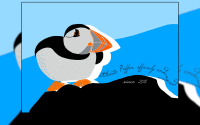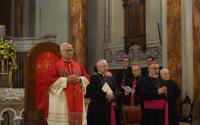21 October 2005The Independent
On a beach at the top of the world, facing out towards the emptiness of the North Pole, the vast and flat Arctic Ocean laps gently at the shoreline. On a clean autumn morning the beach is deserted, and silent but for the wash of the waves. It is calm, it is peaceful but something is very badly wrong. At this time of year the shoreline in this remote, northerly spot should be frozen solid. The sea water should be locked into a huge, ridged ice-sheet many inches thick and stretching for hundreds of miles. But this year, that ice is more than 100 miles from the shore.
"We have been saying this for a number of years," sighed Eugene Brower, the local fire chief in the native Alaskan community of Barrow and captain of a whale-hunting boat. "In the Fall, it takes longer for the ocean to freeze. By now there should be ice here."
The absence of the ice sheet in the small Inupiat community may not appear to be the most striking news. But here in Alaska, the most sparsely populated state in the US, it is just one sign among many that something extraordinary is happening to the landscape. Across its vastness there is evidence of the effects of global warming and its impact on the environment.
On a recent fact-finding tour of Alaska The Independent was confronted by glaciers dating from the last Ice Age that are in rapid retreat; by spruce forests that have been destroyed by a surge in the spruce bark beetle population; and by roads and buildings that have collapsed because the permafrost on which they were built is thawing.
Meanwhile, in the remote north and north-west of the state, millions of dollars are being spent to relocate native villages threatened by erosion, a process exacerbated by the absence of the winter ice which normally protects the shoreline. And everywhere we went there were people - scientists, park rangers, native hunters and ordinary citizens - ready to attest to the changes they had seen themselves. For all the ongoing debate about the extent and causes of global warming, as well as the Bush administration's unwillingness to confront the issue, here in Alaska the evidence is easy to see. Indeed, the evidence is more obvious here than anywhere else. Senators Hillary Clinton and John McCain recently made a similar visit to Alaska. Mrs Clinton returned, warning: "I don't think there's any doubt left for anybody who actually looks at the science. There are still some holdouts, but they're fighting a losing battle."
Two hours south of the city of Anchorage, along roads that pass dead forests of spruce, Exit glacier, near the town of Seward, is one of more than 35 glaciers that flow from the huge Harding ice sheet. The ice of the glacier has been in steady retreat for several hundred years and there are marker posts that show where it reached 20, 50 and even 100 years ago. But in the last 10 years, rangers with the National Parks Service have seen the speed of this retreat greatly accelerate. They say that in the last 10 years the glacier had retreated by 1,000ft. "And that is the length," said ranger Paul Ollig, pointing to a scale model of the glacier in the NPS visitor centre. "We've also lost a significant amount of ice from either side of the glacier and at the top. It's getting a lot thinner."
It's a 10-minute walk to the so-called "zone of ablation" where the front of the three-mile-long glacier is melting. Huge chunks of glistening blue-white ice break off into clean streams that run though the valley floor. You can stand and listen to the constant drip of the melt-water, which may have taken more than 70 years to fall as snow on top of the glacier, be compacted into ice and then flow down the nose of the glacier.
Bob and Cher Nowoc, a couple from North Carolina, were there taking in the views. Neither had any doubts that global warming was taking place but they were unsure about the extent that human activity was to blame. Mrs Nowoc was certain of one thing - that changing human behaviour would be no easy matter. "I think you would have people kicking and screaming," she said. "We're spoiled."
But Exit is not the only disappearing glacier in Alaska. Portage, Holgate, North-western and Medenhall glaciers have all been getting smaller, to the extent that some tour operators in the area say visitors are now being drawn with some urgency to see the glaciers before they shrink even more. Richard Jacoby, operations manager with Kenai Fords Tours, a group which organises boat tours to see the glaciers up close, said: "[The shrinking] of the glaciers is definitely noticeable. North-western glacier has retreated. There used to be huge floes that broke off into the bay but now the glacier is stuck on the ground. It's still on the water's edge but it's no longer floating." He added: "It's hard for people to swallow. [The glaciers] are so huge and so massive that you think they are eternal - like a mountain."
Fairbanks, Alaska's second largest city, has the world's greatest extremes of temperatures, ranging from a record -52C in winter to 37C in summer. It is also where Ruth Macchione and her late husband, Peter, literally made their home. The couple built the 26ft by 16ft (8m by 5m) log cabin by hand almost 50 years ago. But in the late 1970s the couple felt the ground move beneath their feet.
Bit by bit the cabin started to sink. Mrs Macchione placed blocks under the tables in an attempt to keep things level but it was no good. When her husband died in 1987 she was loathe to move from the home they had shared but eventually things became too dangerous and in 1999 she had a new house built nearby. "The last two or three years it really took a dive," she said. "All that hard work for nothing. It's heart-breaking."
The problem was that the ground was melting. Permafrost is the name given to that part of topography that has been constantly frozen since the last Ice Age and in places such as Alaska it had long been considered safe to build homes on permafrost. But in recent years all that has changed due to an increase in soil temperatures in parts of Alaska of three per cent in 30 years. That might not seem much until you consider the average global increase in surface temperatures over the last 100 years has been 0.6C.
Around Fairbanks the implications are considerable. Roads and cycle paths have twisted and buckled, buildings have cracked and across the town there are large "sink holes" where the land has simply fallen in on itself. Residents say the local authority has stopped repairing the damage to roads in anything other than a temporary fashion, knowing that each spring the land will likely melt and sink again.
One of the leading experts on permafrost is one of Mrs Macchione's neighbours. Vladimir Romanovsky, associate professor of geophysics at the University of Alaska, has been studying permafrost for more than 30 years. In the late 1970s, he said, he and others started to notice a change. He believes the situation is currently at a threshold. Large parts of the Alaskan permafrost now have a temperature as warm as -1C. Just a slight warming would have huge consequences.
Professor Romanovsky took The Independent to visit his field experiments in the silver birch woods surrounding the university campus. He has scores of test sites across Alaska where thermometers take soil temperatures all year round and where he tests the depth of the permafrost with a spike. This summer's temperatures at the sites close to the campus were the warmest since Professor Romanovsky started the tests 10 years ago. "We are very, very close to this point when it all starts to thaw," he said.
It is not only damage to infrastructure that will result from the melting permafrost in Alaska and Siberia. Vast amounts of organic material remain frozen within the permafrost and any melting would result in the release of unmeasured amounts of methane and carbon dioxide. The release of these gases would, in turn, add to global warming, impacting Alaska's fragile ecosystem.
Mike Aamodt also knows something about cabins and erosion. On three occasions the former building contractor and teacher has had to move summer hunting cabins that he set up 60 miles from his home in Barrow. He built one in 1996 a full 1,000ft from the shore. By 2002 there was just 30ft between his cabin and the encroaching sea. "In the past the ice used to freeze up in winter and in summer it would drift about 15 miles offshore. The ice would cushion the wave action so that it was not so fierce when it hit our shores," said Mr Aamodt. "Because of warming we have much thinner ice that moves further offshore. Now we have no cushion. When the waves hit they can crack the ground. It's enough to topple it. The ground disappears."
In the remote Inupiat island community of Shishmaref in the far west of Alaska, the erosion has already ended a way of life that had lasted for centuries. At its highest point the island stands at just 22ft, and confronted by thinner protective sea ice and storms that have eroded large chunks of the island, villagers voted to move their community to the mainland in 2002.
Last year the federal government concluded that relocation will cost at least $180m (£102m). Native people say there are a number of similarly threatened villages. Mr Aamodt believes that Barrow - the most northerly community in the US - may also soon have to consider relocation if the current erosion continues. Asked when the situation might become critical, he said: "This month! It could happen at any time. The storm in 2002 flooded right up to the edge of town."
On the outskirts of Barrow, Dan Endres of the National Oceanic and Atmospheric Administrationoverseas 45 different scientific projects measuring climate change. "The Arctic is the mirror to the world. Whatever happens to the rest of the world happens here to a greater extent," he said. His experiments also confirm a 3C increase in 30 years. "You can see it in the [ice-melt] date. We are seven to 10 days earlier in the spring now than 20 years ago. At the same time the freeze-up is getting later."
Mr Brower said the native people were aware of the change before the scientists confirmed their suspicions. "I tell the scientists we are noticing things but they say 'you cannot quantify it'," he said. "But we are living and breathing it every day."






